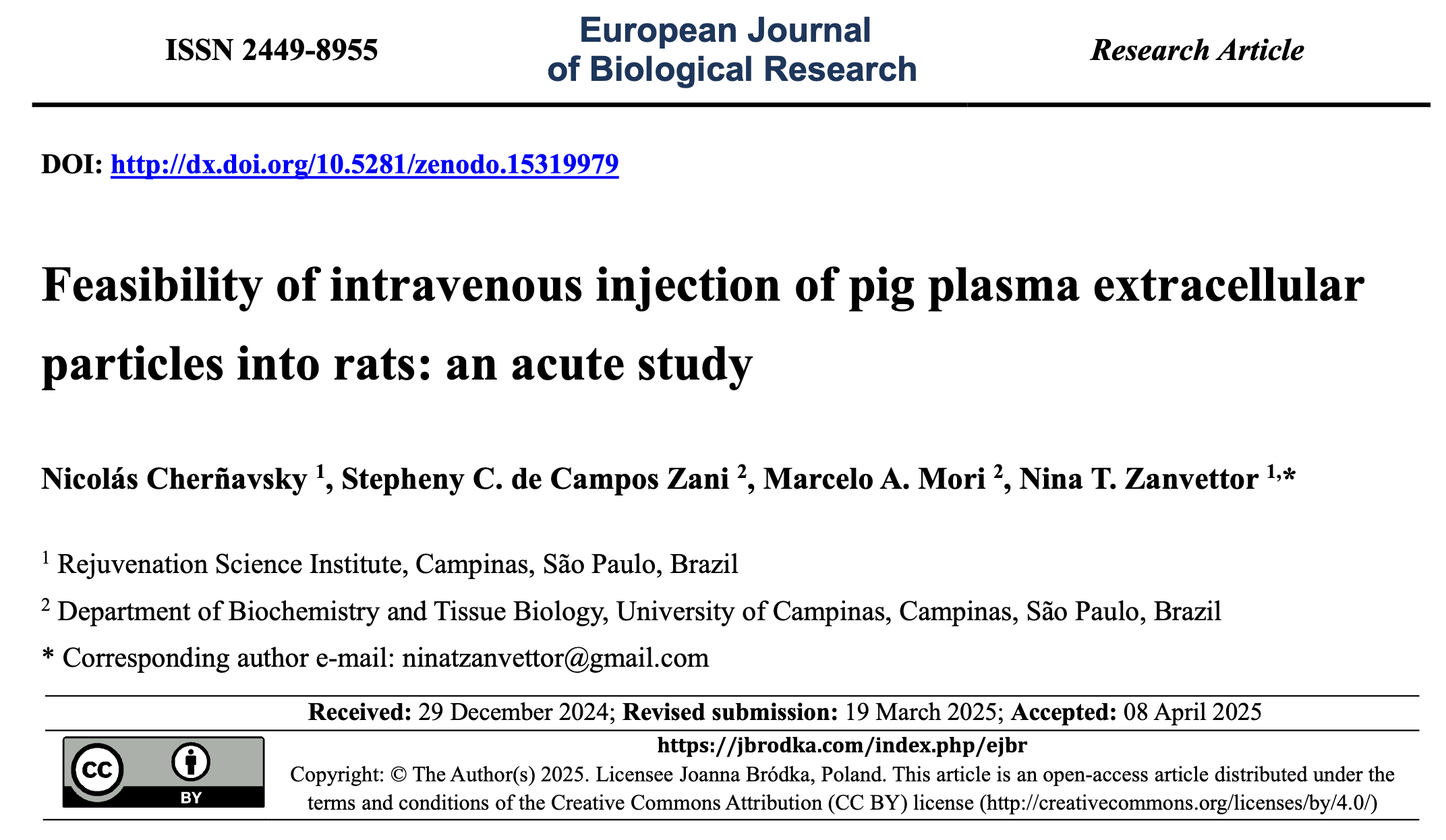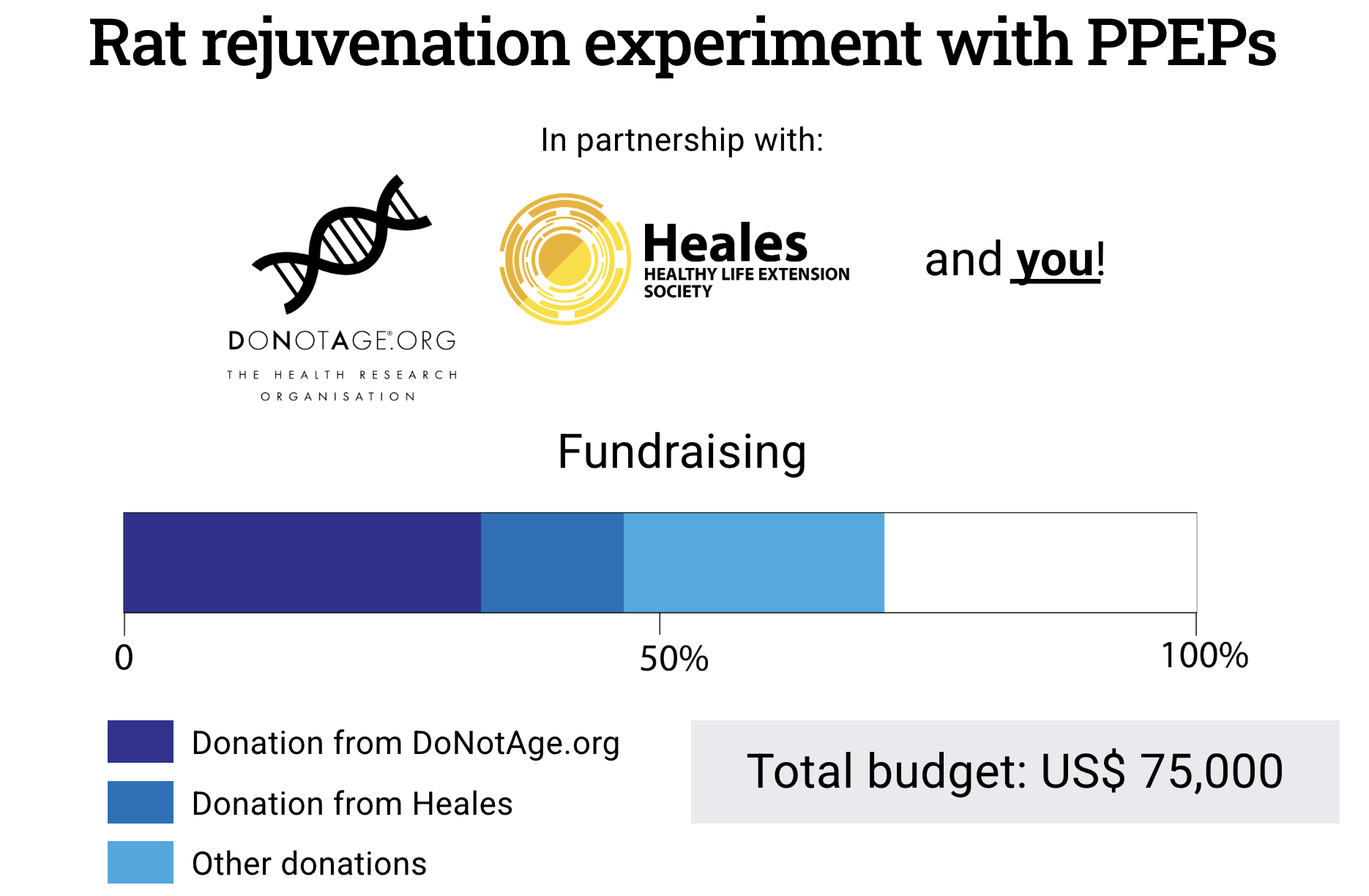31st July 2025 Newsletter
Hi guys. This is the seventh newsletter from the Institute of Rejuvenation Science (ICR). In these newsletters, we will tell you what we've done, since the last newsletter, to accelerate the development of rejuvenation science.
Article published!
In June and July 2024, the ICR conducted a preliminary experiment with Pig Plasma Extracellular Particles (PPEPs) to test their potential acute toxicity and immunogenicity in young Sprague-Dawley rats. The result was that PPEPs are safe from an acute standpoint when injected in large quantities — the same amount used by Harold Katcher in his study published in the journal Geroscience in 2023. Our scientific article, available since December 2024 on BioRxiv, was accepted by the peer-reviewed European Journal of Biological Research in April 2025, but only now, in July 2025, has it been officially published. You can read the article by clicking here.
The ICR in the media
On 20 July 2025, the longevity news website LongevityHub.net published an article in English about the Rat Rejuvenation Experiment with PPEPs. The science outreach article, titled The first immortal mammals are set to be created in 2026, explains for the general public the experiment and its importance to the science of longevity and rejuvenation, and invites readers to become donors to the ICR. To read the article, click here.
Raised funds reach 71% of the total
By the end of July 2025, the ICR has already raised 71% of the total needed to carry out the experiment to rejuvenate rats with PPEPs. This brings the total raised to US$ 53,254, with the remaining 29% still to be raised to reach the total of US$ 75,000. The ICR is contacting as many players in the field of rejuvenation science as possible to inform them about the experiment and the possibility of donations. In addition, we are looking for specialized media that may be interested in publicizing our initiative. So, if you know of a YouTube channel, podcast, newspaper or other media outlet that might be interested in publicizing this experiment, feel free to talk to us about it or directly to the media outlet.
Update on plans following the Rat Rejuvenation Experiment with PPEPs
As we get closer and closer to hitting the fundraising goal for the Rat Rejuvenation Experiment with PPEPs, which will take place in the second semester of 2026, the ICR, together with Professor Marcelo Mori from the University of Campinas (Unicamp), has decided to define in more detail the plans for after the experiment, setting dates for experiments following the rejuvenation experiment.
The Rat Rejuvenation Experiment with PPEPs will be conducted from June 2026 to November 2026. Ten 25-month-old male Sprague-Dawley rats and ten 7-month-old male Sprague-Dawley rats will receive PPEPs treatment in June and September. A control group of 10 male Sprague-Dawley rats aged 25 months and one of 10 male Sprague-Dawley rats aged 7 months will also be used, totaling 40 animals. The animals will be evaluated before, during, and after treatment for memory, grip strength, and blood markers, and epigenetic age will also be measured before and after treatment. This is the experiment for which we are raising $75,000. If the animals show signs of rejuvenation or non-aging, we intend to conduct a longevity experiment next.
The Rat Longevity Experiment with PPEPs would be conducted from December 2026 to November 2027 (12 months). In this experiment, the same animals from the previous experiment would be kept alive, receiving the PPEPs treatment once every 3 months. In addition, we would perform the characterization of the PPEPs. For this experiment, we would have to conduct a new fundraising campaign. If the animals show increased longevity — since in November 2027 the animals that started at 25 months of age would already be 42 months old — we would extend the longevity experiment for another 12 months, raising more funds for this.
Another experiment we intend to conduct if the rat rejuvenation experiment has a positive outcome is the Complete Safety Test for Rats with PPEPs. This test would be conducted at a preclinical testing facility that performs tests in accordance with international safety standards required by regulatory agencies such as Anvisa (Brazil), FDA (USA), and EMA (Europe), following Good Laboratory Practices (GLP). If we can secure funding for this test quickly, it could be conducted in parallel with the longevity experiment during the year 2027.
Finally, if the complete safety test has a positive result, we would conduct a Phase 1 Clinical Trial with PPEPs. The earliest this study could take place would be in 2028, depending on fundraising and when we are able to conduct the complete safety test with Good Laboratory Practices (GLP).
It is urgent to bring this potential rejuvenation treatment to the public, as about 110 thousand people die every day from age-related diseases. We know that the PPEPs technology could theoretically be improved, but if human trials are successful, we want to make this therapy available to humanity as soon as possible, and later (or in parallel) improve it.
Our president Nicolás Cherñavsky explains in a video what would happen if rats are rejuvenated
During the month of July 2025, the president of the ICR, Nicolás Cherñavsky, published a video in Spanish explaining what, in his view, will happen if the rejuvenation experiment has a positive outcome and the rats rejuvenate. You can watch the video by clicking here. If you think it's a good idea, you can share the video with friends, family and acquaintances. The video is in Spanish, but if you don’t speak Spanish, by activating the simultaneous translation feature of YouTube's subtitles you can understand almost everything. It's important to remember that in addition to YouTube, ICR publishes content and updates on two other social networks, Instagram and LinkedIn.
This is a collective effort
This experiment is a collective effort to reproduce Harold Katcher's seminal study, in which the ICR relies on the contribution of those interested in the realization of the experiment. Thus, if you know someone who might be interested in the content of this newsletter, you can forward it to them. Also, if you are not yet a financial contributor of the ICR, we invite you to become one by clicking on this link.
So that's it. We're carrying on, and we won't rest until we've implemented rejuvenation in human beings. See you next time!


